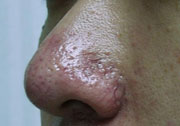There is still no answer as what causes rosacea. There have been many theories, including the helicobacter pylori in stomach ulcer, and hormonal imbalance, but none of them is confirmed to play a part.
Since the main symptom in rosacea is the flushing, one reasonable suggestion is that the blood vessels in the face are over-sensitive to some normal stimulating signals, with resulting inflammation in the follicles and oily glands.
This is a very common problem and affects our appearance. Generally it is more common in females in the age group of 20 - 40, but is more severe when it happens in the males. Because of its red-faced, acne-like effects, it can cause significant psychological, social and occupational problems if left untreated.
Signs
Typical signs and symptoms include facial flushing, redness, burning, red bumps, and cysts. Initially, the face turns red under a hot stuffy environment, or after exercise. This is intermittent and the redness tends to come and go, lasting for only minutes.
The symptoms will gradually happen more often and last for longer, and eventually turning into a semi-permanent and then permanent flushing.
Later on the blood vessels on the cheeks and nose will become dilated and obvious. First they are thin, but then will get larger and appear purplish red.
|
|
|
|
Typical Distribution
|
Dilated Blood Vessels
|
In the next stage, there will be acne-like little papules, which can be itchy and contain pus.
The flushing, dilated blood vessels, and papules can appear either independently, or altogether. They go away when the skin is cooled down. The sequence may be different. Some sufferers may only have the papules, while some may have all three of them.
If left untreated for a long time, because of the inflammation, the skin on the face is hardened and swollen. The nose will appear lumpy and swollen like a strawberry. This disfiguring nose condition is called rhinophyma, which occurs mainly in the males, and may require surgical repair.
Some people will have complications affecting the eyes, such as dry eyes, conjunctivitis and even keratitis (inflammation of the cornea).
Management & Treatments
Rosacea cannot be cured; but it can usually be controlled with proper, regular treatments. Mild rosacea may not necessarily require treatment if the individual is not bothered by the condition. More resistant cases may require a combination approach, using several of the treatments at the same time.
A combination approach may include antibiotic cream morning and night, and taking an oral antibiotic for flares. A series of in-office laser, intense pulsed light, or photodynamic therapies may also be used in combination with the home regimen.
Since there is some overlap between acne and rosacea, some of the medications may be similar. Acne and rosacea have in common several possible treatments including oral antibiotics, topical antibiotics, and isotretinoin.
General Measures
Hot stuffy environment will aggravate the symptoms and should be avoided. Sunscreen should be used when going under the sun. Too hot or too cold weather will affect the contraction and dilation of blood vessels. Hot and spicy food, coffee, tea, and alcohol all make rosacea worse and should be avoided or kept to a minimum.
Topical & Oral Antibiotics
They are used for their anti-inflammatory effect, not to kill bacteria. Mils cases can use topical metronidazole, clindamycin, or erythromycin. When more severe, oral erythromycin, doxycycline, minocycline, or tetracycline can be used. Some doctors also find oral metronidazole helpful.
Isotretinoin
Isotretinoin has been prescribed to patients with severe rosacea. However, close physician monitoring and blood testing are necessary while on isotretinoin.
Topical Steroid
Short-term topical steroid preparations of minimal strength may in occasional cases be used to reduce local inflammation. It should not be used often or for a long period because it may actually cause a flare up.
Laser and Intense Pulsed Light
Many patients are now turning to laser and intense-light treatments to treat the continual redness and noticeable blood vessels on the face, neck, and chest. Often considered a safe alternative, laser and intense pulse-light therapy may help to visibly improve the skin and complexion.
Treatments are recommended every 3 - 6 weeks; during this time, sun avoidance is necessary. Risk, benefits, and alternatives should be reviewed with your physician prior to treatment. Laser treatments may be combined with photodynamic therapy for more noticeable results.



